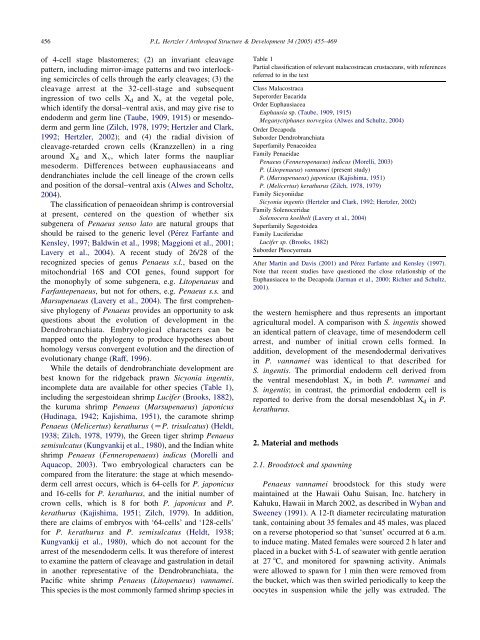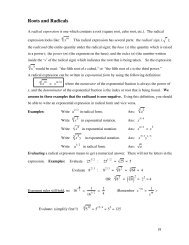Cleavage and gastrulation in the shrimp Penaeus (Litopenaeus ...
Cleavage and gastrulation in the shrimp Penaeus (Litopenaeus ...
Cleavage and gastrulation in the shrimp Penaeus (Litopenaeus ...
You also want an ePaper? Increase the reach of your titles
YUMPU automatically turns print PDFs into web optimized ePapers that Google loves.
456<br />
of 4-cell stage blastomeres; (2) an <strong>in</strong>variant cleavage<br />
pattern, <strong>in</strong>clud<strong>in</strong>g mirror-image patterns <strong>and</strong> two <strong>in</strong>terlock<strong>in</strong>g<br />
semicircles of cells through <strong>the</strong> early cleavages; (3) <strong>the</strong><br />
cleavage arrest at <strong>the</strong> 32-cell-stage <strong>and</strong> subsequent<br />
<strong>in</strong>gression of two cells Xd <strong>and</strong> Xv at <strong>the</strong> vegetal pole,<br />
which identify <strong>the</strong> dorsal–ventral axis, <strong>and</strong> may give rise to<br />
endoderm <strong>and</strong> germ l<strong>in</strong>e (Taube, 1909, 1915) or mesendoderm<br />
<strong>and</strong> germ l<strong>in</strong>e (Zilch, 1978, 1979; Hertzler <strong>and</strong> Clark,<br />
1992; Hertzler, 2002); <strong>and</strong> (4) <strong>the</strong> radial division of<br />
cleavage-retarded crown cells (Kranzzellen) <strong>in</strong> a r<strong>in</strong>g<br />
around Xd <strong>and</strong> Xv, which later forms <strong>the</strong> naupliar<br />
mesoderm. Differences between euphausiaceans <strong>and</strong><br />
dendranchiates <strong>in</strong>clude <strong>the</strong> cell l<strong>in</strong>eage of <strong>the</strong> crown cells<br />
<strong>and</strong> position of <strong>the</strong> dorsal–ventral axis (Alwes <strong>and</strong> Scholtz,<br />
2004).<br />
The classification of penaeoidean <strong>shrimp</strong> is controversial<br />
at present, centered on <strong>the</strong> question of whe<strong>the</strong>r six<br />
subgenera of <strong>Penaeus</strong> senso lato are natural groups that<br />
should be raised to <strong>the</strong> generic level (Pérez Farfante <strong>and</strong><br />
Kensley, 1997; Baldw<strong>in</strong> et al., 1998; Maggioni et al., 2001;<br />
Lavery et al., 2004). A recent study of 26/28 of <strong>the</strong><br />
recognized species of genus <strong>Penaeus</strong> s.l., based on <strong>the</strong><br />
mitochondrial 16S <strong>and</strong> COI genes, found support for<br />
<strong>the</strong> monophyly of some subgenera, e.g. <strong>Litopenaeus</strong> <strong>and</strong><br />
Farfantepenaeus, but not for o<strong>the</strong>rs, e.g. <strong>Penaeus</strong> s.s. <strong>and</strong><br />
Marsupenaeus (Lavery et al., 2004). The first comprehensive<br />
phylogeny of <strong>Penaeus</strong> provides an opportunity to ask<br />
questions about <strong>the</strong> evolution of development <strong>in</strong> <strong>the</strong><br />
Dendrobranchiata. Embryological characters can be<br />
mapped onto <strong>the</strong> phylogeny to produce hypo<strong>the</strong>ses about<br />
homology versus convergent evolution <strong>and</strong> <strong>the</strong> direction of<br />
evolutionary change (Raff, 1996).<br />
While <strong>the</strong> details of dendrobranchiate development are<br />
best known for <strong>the</strong> ridgeback prawn Sicyonia <strong>in</strong>gentis,<br />
<strong>in</strong>complete data are available for o<strong>the</strong>r species (Table 1),<br />
<strong>in</strong>clud<strong>in</strong>g <strong>the</strong> sergestoidean <strong>shrimp</strong> Lucifer (Brooks, 1882),<br />
<strong>the</strong> kuruma <strong>shrimp</strong> <strong>Penaeus</strong> (Marsupenaeus) japonicus<br />
(Hud<strong>in</strong>aga, 1942; Kajishima, 1951), <strong>the</strong> caramote <strong>shrimp</strong><br />
<strong>Penaeus</strong> (Melicertus) kerathurus (ZP. trisulcatus) (Heldt,<br />
1938; Zilch, 1978, 1979), <strong>the</strong> Green tiger <strong>shrimp</strong> <strong>Penaeus</strong><br />
semisulcatus (Kungvankij et al., 1980), <strong>and</strong> <strong>the</strong> Indian white<br />
<strong>shrimp</strong> <strong>Penaeus</strong> (Fenneropenaeus) <strong>in</strong>dicus (Morelli <strong>and</strong><br />
Aquacop, 2003). Two embryological characters can be<br />
compared from <strong>the</strong> literature: <strong>the</strong> stage at which mesendoderm<br />
cell arrest occurs, which is 64-cells for P. japonicus<br />
<strong>and</strong> 16-cells for P. kerathurus, <strong>and</strong> <strong>the</strong> <strong>in</strong>itial number of<br />
crown cells, which is 8 for both P. japonicus <strong>and</strong> P.<br />
kerathurus (Kajishima, 1951; Zilch, 1979). In addition,<br />
<strong>the</strong>re are claims of embryos with ‘64-cells’ <strong>and</strong> ‘128-cells’<br />
for P. kerathurus <strong>and</strong> P. semisulcatus (Heldt, 1938;<br />
Kungvankij et al., 1980), which do not account for <strong>the</strong><br />
arrest of <strong>the</strong> mesendoderm cells. It was <strong>the</strong>refore of <strong>in</strong>terest<br />
to exam<strong>in</strong>e <strong>the</strong> pattern of cleavage <strong>and</strong> <strong>gastrulation</strong> <strong>in</strong> detail<br />
<strong>in</strong> ano<strong>the</strong>r representative of <strong>the</strong> Dendrobranchiata, <strong>the</strong><br />
Pacific white <strong>shrimp</strong> <strong>Penaeus</strong> (<strong>Litopenaeus</strong>) vannamei.<br />
This species is <strong>the</strong> most commonly farmed <strong>shrimp</strong> species <strong>in</strong><br />
P.L. Hertzler / Arthropod Structure & Development 34 (2005) 455–469<br />
Table 1<br />
Partial classification of relevant malacostracan crustaceans, with references<br />
referred to <strong>in</strong> <strong>the</strong> text<br />
Class Malacostraca<br />
Superorder Eucarida<br />
Order Euphausiacea<br />
Euphausia sp. (Taube, 1909, 1915)<br />
Meganyctiphanes norvegica (Alwes <strong>and</strong> Schultz, 2004)<br />
Order Decapoda<br />
Suborder Dendrobranchiata<br />
Superfamily Penaeoidea<br />
Family Penaeidae<br />
<strong>Penaeus</strong> (Fenneropenaeus) <strong>in</strong>dicus (Morelli, 2003)<br />
P. (<strong>Litopenaeus</strong>) vannamei (present study)<br />
P. (Marsupenaeus) japonicus (Kajishima, 1951)<br />
P. (Melicertus) kerathurus (Zilch, 1978, 1979)<br />
Family Sicyoniidae<br />
Sicyonia <strong>in</strong>gentis (Hertzler <strong>and</strong> Clark, 1992; Hertzler, 2002)<br />
Family Solenoceridae<br />
Solenocera koelbeli (Lavery et al., 2004)<br />
Superfamily Segestoidea<br />
Family Luciferidae<br />
Lucifer sp. (Brooks, 1882)<br />
Suborder Pleocyemata<br />
After Mart<strong>in</strong> <strong>and</strong> Davis (2001) <strong>and</strong> Pérez Farfante <strong>and</strong> Kensley (1997).<br />
Note that recent studies have questioned <strong>the</strong> close relationship of <strong>the</strong><br />
Euphausiacea to <strong>the</strong> Decapoda (Jarman et al., 2000; Richter <strong>and</strong> Schultz,<br />
2001).<br />
<strong>the</strong> western hemisphere <strong>and</strong> thus represents an important<br />
agricultural model. A comparison with S. <strong>in</strong>gentis showed<br />
an identical pattern of cleavage, time of mesendoderm cell<br />
arrest, <strong>and</strong> number of <strong>in</strong>itial crown cells formed. In<br />
addition, development of <strong>the</strong> mesendodermal derivatives<br />
<strong>in</strong> P. vannamei was identical to that described for<br />
S. <strong>in</strong>gentis. The primordial endoderm cell derived from<br />
<strong>the</strong> ventral mesendoblast X v <strong>in</strong> both P. vannamei <strong>and</strong><br />
S. <strong>in</strong>gentis; <strong>in</strong> contrast, <strong>the</strong> primordial endoderm cell is<br />
reported to derive from <strong>the</strong> dorsal mesendoblast Xd <strong>in</strong> P.<br />
kerathurus.<br />
2. Material <strong>and</strong> methods<br />
2.1. Broodstock <strong>and</strong> spawn<strong>in</strong>g<br />
<strong>Penaeus</strong> vannamei broodstock for this study were<br />
ma<strong>in</strong>ta<strong>in</strong>ed at <strong>the</strong> Hawaii Oahu Suisan, Inc. hatchery <strong>in</strong><br />
Kahuku, Hawaii <strong>in</strong> March 2002, as described <strong>in</strong> Wyban <strong>and</strong><br />
Sweeney (1991). A 12-ft diameter recirculat<strong>in</strong>g maturation<br />
tank, conta<strong>in</strong><strong>in</strong>g about 35 females <strong>and</strong> 45 males, was placed<br />
on a reverse photoperiod so that ‘sunset’ occurred at 6 a.m.<br />
to <strong>in</strong>duce mat<strong>in</strong>g. Mated females were sourced 2 h later <strong>and</strong><br />
placed <strong>in</strong> a bucket with 5-L of seawater with gentle aeration<br />
at 27 8C, <strong>and</strong> monitored for spawn<strong>in</strong>g activity. Animals<br />
were allowed to spawn for 1 m<strong>in</strong> <strong>the</strong>n were removed from<br />
<strong>the</strong> bucket, which was <strong>the</strong>n swirled periodically to keep <strong>the</strong><br />
oocytes <strong>in</strong> suspension while <strong>the</strong> jelly was extruded. The



